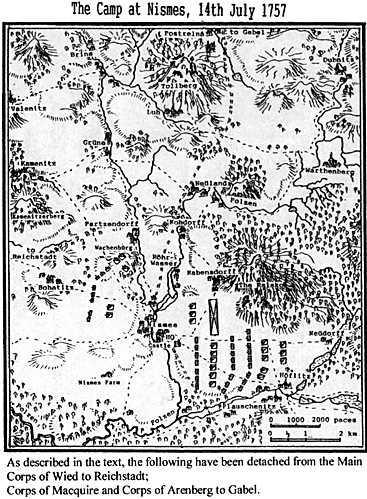The army left Hühnerwasser to go and encamp at Nismes.
Order of March from Hühnerwasser to Nismes
- The army marched at first light in four columns; each Wing marched separately.
The 1st Column, composed of all the cavalry of the Right Wing – Regiment Anhalt-Zerbst leading, took the road from Wöken to Neüdorff, where the great pond of Plauschenitz lies to the left. It then continued its route crossing a vineyard near the Neüdorff mill before entering camp around Nismes. The Second Line of this cavalry passed through Motschen where it joined on behind the Regiment Archduke Joseph and followed it to the new camp.
The 2nd Column, made up of all the infantry of the Right Wing – Regiment Nikolaus Esterházy at the head, marched by its left. Leaving Wöken on its left, it passed by the glass-works and continued to Plauschenitz, leaving the great pond on its right. Then it passed the dyke beside the windmill at Höflitz and continued its march to enter camp near Nismes.
The 3rd Column, comprising all the infantry of the Left Wing, marched by its left leaving Hühnerwasser on its left. It took the route called the Millen road, traversed the wood, and passed the two villages of Höflitz and Plauschenitz near the Forst mansion, where we had constructed a new bridge. It then continued its way to camp.
The 4th Column, made up of the cavalry of the Left Wing – Regiment Savoyen leading the way, passed close to Hühnerwasser, leaving that town just to its left. It then took the new road to Plauschenitz, where it crossed the river on the stone bridge. From there it continued its march until it reached the neighborhood of Nismes, where it entered its new camp.
The Reserve Corps followed the 4th Column as far as Nismes. There, it crossed a bridge, left the cemetery to its right, and continued its route as far as a height near which it encamped.
The Reserve Artillery followed the 2nd Column.
The baggage followed their respective columns.
The army encamped in six lines. The right rests upon a mountain; the left is on the Polzen, which flows beside the wood through which we came from Hühnerwasser. 8 battalions of the Reserve are encamped in front of the army to cover the Headquarters at Nismes.
A detachment of Croats and hussars, under the orders of Generals Beck and Marocz, had approached the castle at Reichstadt, which belongs to Prince Clement of Bavaria. They discovered that it was garrisoned by no more than two battalions of Prussians. In consequence of this intelligence, yesterday evening, we sent several companies of grenadiers and 4 battalions with several heavy cannon to support the Croats in their attack on that post, which was to have been made at first light this morning. Unfortunately, the bad roads slowed down the march of our troops; this allowed time for the Prussians to throw in 4 more battalions to reinforce the garrison. Meanwhile, the Croats rendered themselves masters of the village, where they took 16 prisoners. This operation would have been a greater success if the Austrians had not sought to be so careful in sparing the town and the castle from damage. The Croats had a captain and 10 men killed and a captain and 11 men wounded. During this skirmish, 28 Prussians deserted and joined the Austrians.
General Macquire reports that he has invested the small town of Gabel. Inside, there are 4 Prussian battalions with 8 cannon, I squadron of hussars and several sick. After a very lively fire he made himself master of one of the gates of the town. The general did not wish to reduce the town to cinders. Having no more than 3,000 men with him, he felt obliged to withdraw his troops onto the heights in order to await the heavy cannon and the reinforcements that His Royal Highness has hastily sent to him under the command of the Duke of Arenberg. General Macquire further tells us that he captured one cannon in the suburbs together with 110 provision wagons filled with oats. General Macquire had commanded at Gabel during the Winter; thus, he personally knows the ground very well.
The fixed garrison of Gabel was no more than two Prussian battalions; but the Austrians had not known that, by chance, two other battalions, escorting some 500 wagons, were on their way to Zittau to fetch bread for the Army of the Prince of Prussia. Those two battalions, and their wagons, threw themselves into Gabel.
Now that the Austrians have marched to Nismes, we presume that the King of Prussia will come towards Leipa with the main body of his army. The troops with the Prince of Prussia at Leipa are not sufficient to protect Gabel as well as that town. In consequence, if the Prince of Prussia is not reinforced at Leipa, he will be unable to maintain his communications with Zittau.

More Journal of Horace St. Paul 1757
- Introduction and June 28, 1757
June 29, 1757
June 30, 1757
July 1, 1757
July 2, 1757
July 3, 1757
July 4, 1757
July 5, 1757
July 6, 1757
July 7, 1757
July 8, 1757
July 9, 1757
July 10, 1757
July 11, 1757
July 12, 1757
July 13, 1757
July 14, 1757
Back to Seven Years War Asso. Journal Vol. XI No. 2 Table of Contents
Back to Seven Years War Asso. Journal List of Issues
Back to Master Magazine List
© Copyright 2000 by James J. Mitchell
This article appears in MagWeb (Magazine Web) on the Internet World Wide Web.
Other military history articles and gaming articles are available at http://www.magweb.com